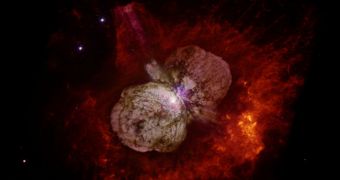Astronomers recently came to an agreement that Eta Carinae, one of the largest stars in the known Universe, might explode without forewarning at any time. This is important news for us because the object is just some 7,500 light-years away from Earth, practically in our backyard.
In all fairness, the massive star may have already exploded thousands of years ago, given that it take 7,500 years for its light to reach Earth. But, that aside, astronomers say that the object's future evolution has been estimated based on another event.
Recently, scientists observed SN2006gy, a supernova explosion event that was the most powerful and bright on record. Given that the properties of the original massive star were similar to those of Eta Carinae, experts concluded that the same unexpected course of events may follow here as well.
Our neighboring star can be seen in the Southern Sky, eastwards of the Keyhole Nebula. It is a super-luminous eruptive star, which means that it's over one million times brighter than the Sun, as well as at least one hundred times more massive.
The reason why astronomers began taking an interest in its evolution is because of a historic event called the Great Eruption, that took place in the mid-1800s, and which was provoked by a massive explosion that shook Eta Carinae to the core.
Despite the strength and intensity of the blow, which had many of the characteristics usually associated with a supernova event, the star survived. However, it did lose about 10 solar masses-worth of material, which went on to create the nebula we see around the star today.
The attached image shows how Eta Carinae looked like after the 1840s explosion. It is a composite photo, combining data from the NASA Chandra X-ray Observatory and Hubble Space Telescope.
According to astronomers, whenever the massive star decides to blow up, the event will be seen from Earth with the naked eye. The supernova event will most likely produce a fireball in the night sky that will rival the full Moon in brightness.
It is widely known that supernovae can briefly outshine entire galaxies, and Eta Carinae is one of the largest stars in the Milky Way, if not even the largest.
The reason why it's acting up is because it's reaching the end of its burning cycle, which means that the supplies of hydrogen that are supporting nuclear fusion are running low.
The star is now in a very unstable balance, and any slight disturbance could cause massive explosions from its surface, such as the one in the mid-1800s.
When Eta Carinae goes supernova, it will most likely produce a black hole, or at least a neutron star, Daily Galaxy reports.

 14 DAY TRIAL //
14 DAY TRIAL //